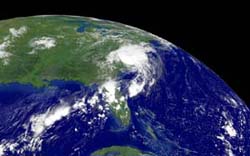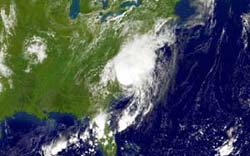| NOAA Magazine || NOAA Home Page || Previous Story |
CHARLEY INLAND OVER NORTHEASTERN NORTH CAROLINA
(DISCLAIMER:
See the NOAA National Hurricane
Center for the latest information on this storm.
Complete advisories are posted at 11 a.m., 5 p.m., 11 p.m. and 5
a.m. All times are Eastern. Advisories are posted more frequently
as the storm nears the USA mainland.) |
|||
Latest
NOAA Satellite Image of Charley (Visible) |
|||
 Aug.
14, 2004 — At 5 p.m. EDT, the center of Tropical Storm Charley was
located near latitude 36.0 north, longitude 77.0 west. This position is
over northeastern North Carolina and about 75 miles south-southwest of
Norfolk, Va. Charley is moving toward the north-northeast near 30 mph,
and a gradual turn toward the northeast is expected on Sunday. On this
track, Charley will move near and along the U.S. northeast coast, according
to the NOAA National Hurricane Center
in Miami, Fla. (Click NOAA satellite image for larger view of
Hurricane Charley taken at 1:45 p.m. EDT on Aug. 14, 2004, as it made
landfall over North Carolina. Click
here for high resolution version, which is a large file. Please credit
“NOAA.”)
Aug.
14, 2004 — At 5 p.m. EDT, the center of Tropical Storm Charley was
located near latitude 36.0 north, longitude 77.0 west. This position is
over northeastern North Carolina and about 75 miles south-southwest of
Norfolk, Va. Charley is moving toward the north-northeast near 30 mph,
and a gradual turn toward the northeast is expected on Sunday. On this
track, Charley will move near and along the U.S. northeast coast, according
to the NOAA National Hurricane Center
in Miami, Fla. (Click NOAA satellite image for larger view of
Hurricane Charley taken at 1:45 p.m. EDT on Aug. 14, 2004, as it made
landfall over North Carolina. Click
here for high resolution version, which is a large file. Please credit
“NOAA.”)
Maximum sustained winds are near 70 mph with higher gusts. Weakening is
forecast during the next 24 hours.
![]() Tropical
storm force winds extend outward up to 85 miles mainly to the east of
the center. (Click NOAA Tropical Storm Charley tracking map for
larger view.)
Tropical
storm force winds extend outward up to 85 miles mainly to the east of
the center. (Click NOAA Tropical Storm Charley tracking map for
larger view.)
The estimated minimum central pressure is 1000 mb, 29.53 inches.
Storm surge flooding of up to 4 feet above normal tide levels along the
southern coast of North Carolina will subside Saturday night. Storm surge
flooding of 2 to 3 feet above normal tide levels is expected along the
U.S. central and northeast coast Saturday night and early Sunday as Charley
moves by.
Rainfall
totals of 2 to 4 inches are likely along the path of Charley over the
central and northeast U.S. coastal states.
Isolated tornadoes are possible over portions of northeastern North Carolina
and southeastern Virginia.
 (Click NOAA long distance satellite image for larger view of Hurricane Charley taken at 12:45 p.m. EDT on Aug 14, 2004, lashing North Carolina as it made landfall. Click here for high resolution version, which is a large file. Please credit “NOAA.”) |
 (Click NOAA overhead satellite image for larger view of Hurricane Charley taken at 12:45 p.m. EDT on Aug. 14, 2004, as it came ashore over North Carolina. Click here for high resolution version, which is a large file. Please credit “NOAA.”) |
 (Click NOAA angled satellite image for larger view of Hurricane Charley taken at 12:45 p.m. EDT on Aug. 14, 2004, as the once-powerful storm came ashore for a second time; this time over North Carolina. Click here for high resolution version, which is a large file. Please credit “NOAA.”) |
 (Click NOAA satellite image for larger view of Tropical Depression Five taken 12:45 p.m. on Aug. 14, 2004, which bears watching because its track is similar to that of Hurricane Charley. Click here for high resolution version, which is a large file. Please credit “NOAA.”) |
A tropical storm warning remains in effect from Cape Lookout, N.C., northward to the Merrimack River, Mass., including the Pamlico and Albemarle Sounds, the Tidal Potomac, Chesapeake Bay, Delaware Bay, New York Harbor and Long Island Sound. At 5 p.m. EDT, warnings are discontinued south of Cape Lookout.
For storm
information specific to your area, please monitor products issued by NOAA
National Weather Service local forecast offices and statements from
local emergency management officials.
NOAA is dedicated to enhancing economic security and national safety through
the prediction and research of weather and climate-related events and
providing environmental stewardship of the nationís coastal and marine
resources. NOAA is part of the U.S.
Department of Commerce.
Relevant
Web Sites
NOAA
National Hurricane Center —
Get the latest advisories here
NOAA
Satellite Services Division — Latest Images
NOAA 3-D Satellite Images
NOAA Enhanced Satellite
Images
NOAA Atlantic Hurricanes
Database — 150 Years of Atlantic Hurricanes
Above-normal
2004 Atlantic Hurricane Season Predicted
Saffir-Simpson Hurricane
Scale
NOAA Flood Products
NOAA
Inland Flooding Information
Significant
River Flood Outlook
NOAA Rainfall Graphics
24-hour
Observed Precipitation as of 8 a.m. today
Latest
rainfall data as of 8 a.m. EDT today
NOAA Buoys
NOAA
Tides Online
NOAA Satellite Images — The
latest satellite views
Colorized Satellite Images
NOAA Hurricanes Page
NOAA Storm Watch —
Get the latest severe weather information across the USA
Media
Contact:
Frank Lepore, NOAA
Hurricane Center, (305) 229-4404